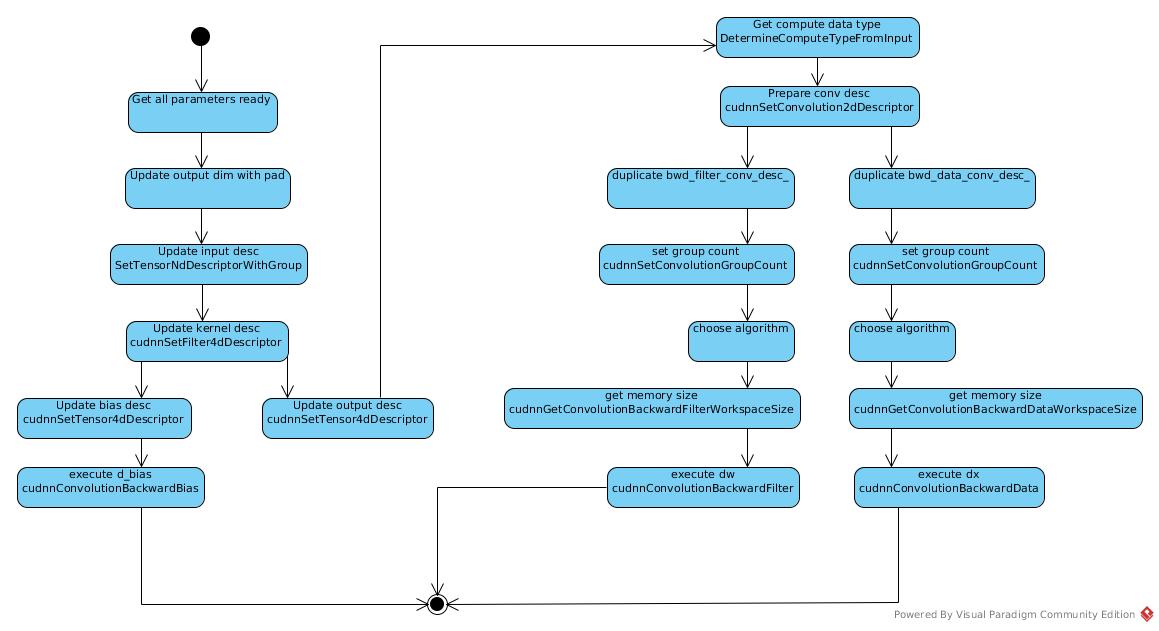Convolution Operation
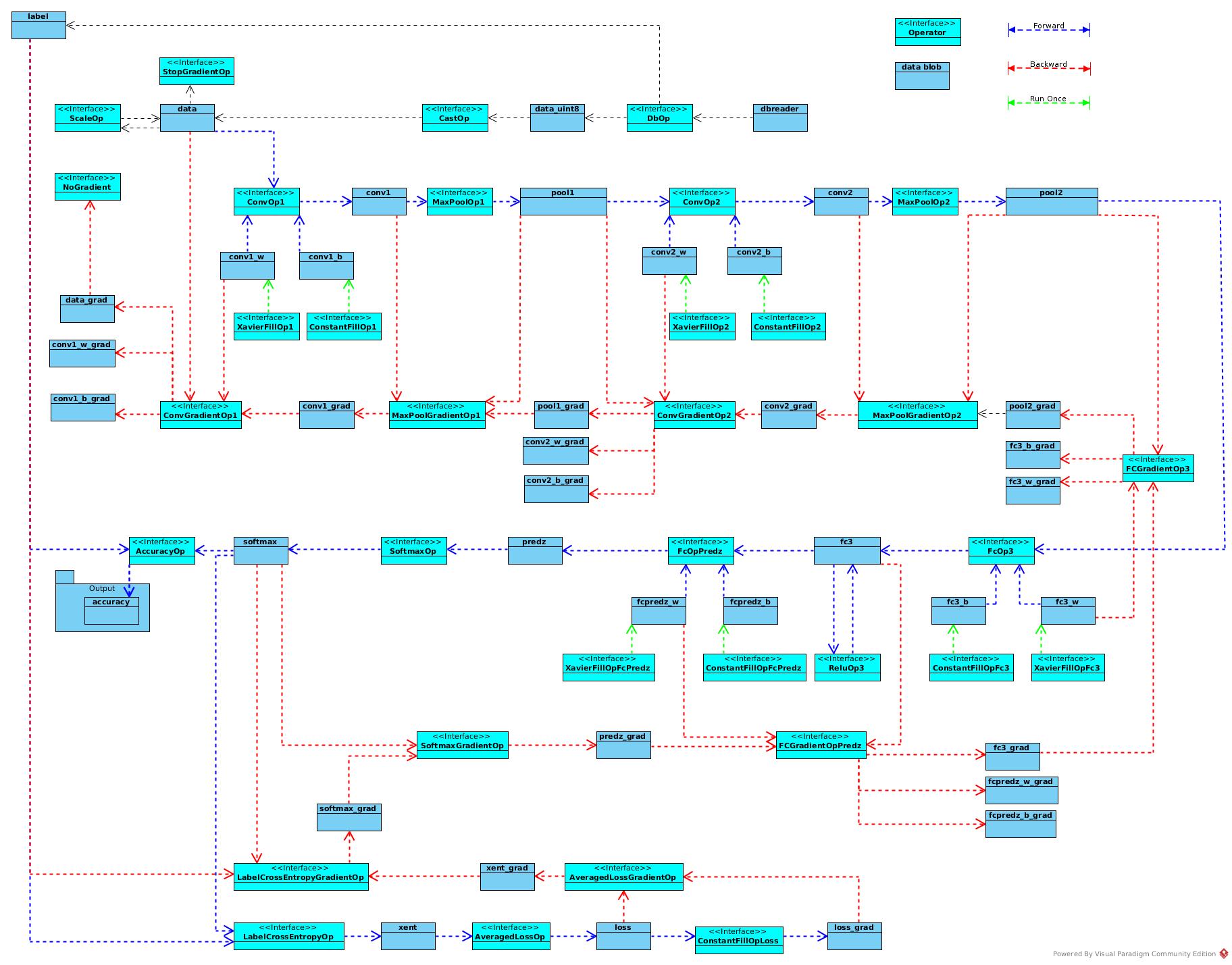
Initiation
Class Diagram
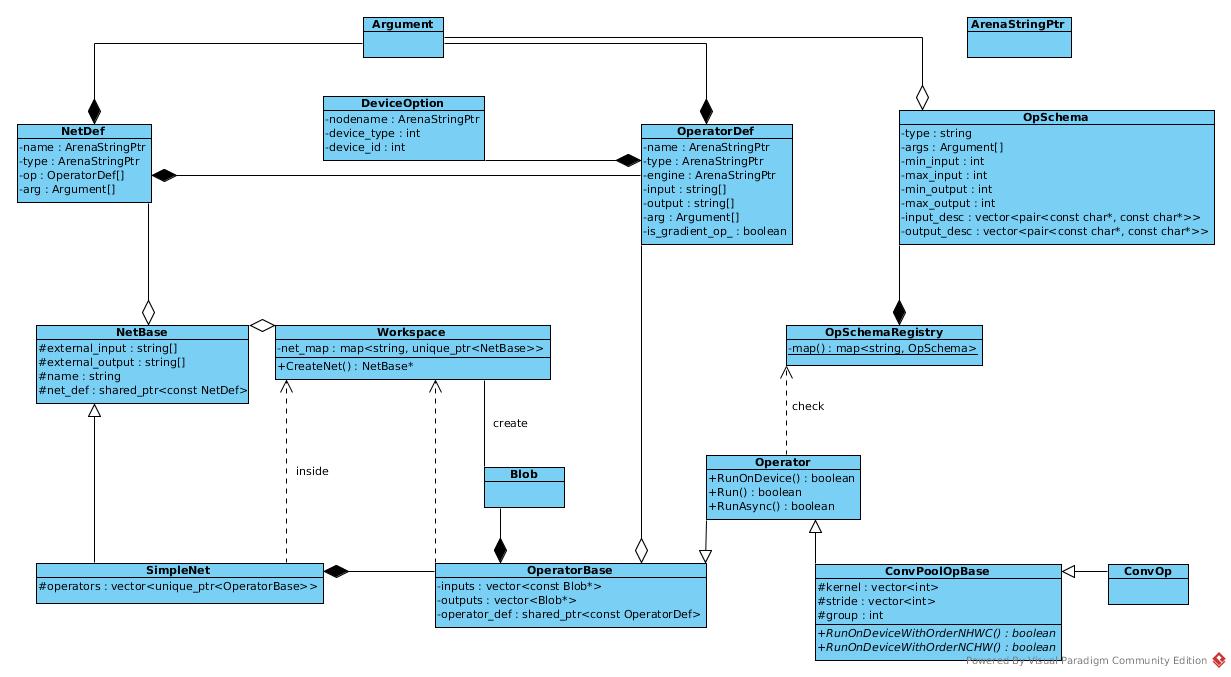
Operator object is created based on OperatorDef.
In operator.cc:
unique_ptr<OperatorBase> _CreateOperator(
const OperatorDef& operator_def,
Workspace* ws) {
In runtime, the schema just works as a validator:
auto* schema = OpSchemaRegistry::Schema(op_type);
if (schema) {
CAFFE_ENFORCE(
schema->Verify(operator_def),
"Operator def did not pass schema checking: ",
ProtoDebugString(operator_def));
}
Create through registry:
unique_ptr<OperatorBase> TryCreateC10Operator(
const string& key,
const OperatorDef& operator_def,
Workspace* ws) {
return C10OperatorRegistry()->Create(key, operator_def, ws);
}
The creator is registered in conv_op.cc
REGISTER_CPU_OPERATOR(Conv, ConvOp<float, CPUContext>);
So, the constructor is invoked:
public:
USE_CONV_POOL_BASE_FUNCTIONS(Context);
ConvOp(const OperatorDef& operator_def, Workspace* ws)
: ConvPoolOpBase<Context>(operator_def, ws) {
The convolution specific arguments are initiated in parent class:
public:
USE_OPERATOR_CONTEXT_FUNCTIONS;
ConvPoolOpBase(const OperatorDef& operator_def, Workspace* ws)
: Operator<Context>(operator_def, ws),
legacy_pad_(
static_cast<LegacyPadding>(this->template GetSingleArgument<int>(
"legacy_pad",
LegacyPadding::NOTSET))),
global_pooling_(
//ZF: GetSingleArgument / GetRepeatedArgument
this->template GetSingleArgument<int>("global_pooling", 0)),
kernel_(this->template GetRepeatedArgument<int>("kernels")),
dilation_(this->template GetRepeatedArgument<int>("dilations")),
stride_(this->template GetRepeatedArgument<int>("strides")),
pads_(this->template GetRepeatedArgument<int>("pads")),
float16_compute_(
this->template GetSingleArgument<bool>("float16_compute", false)),
group_(this->template GetSingleArgument<int>("group", 1)),
order_(StringToStorageOrder(
this->template GetSingleArgument<string>("order", "NCHW"))),
//ZF: What's shared_buffer for?
shared_buffer_(
this->template GetSingleArgument<int>("shared_buffer", 0)),
ws_(ws) {
The input/output are initiated in base class OperatorBase:
But seemed that the OperatorDef in specified class has only check/validation/test functions.
OperatorBase::OperatorBase(const OperatorDef& operator_def, Workspace* ws)
: operator_ws_(ws),
operator_def_(std::make_shared<OperatorDef>(operator_def)),
device_option_(
operator_def.has_device_option() ? operator_def.device_option()
: DeviceOption()),
event_(caffe2::make_unique<Event>(device_option_)) {
static GlobalInitIsCalledGuard guard;
for (const string& input_str : operator_def.input()) {
auto* blob = ws->GetBlob(input_str);
CAFFE_ENFORCE(
blob != nullptr,
"op ",
operator_def.type(),
": Encountered a non-existing input blob: ",
input_str);
inputs_.push_back(blob);
}
GetOperatorLogger()(operator_def);
for (const string& output_str : operator_def.output()) {
outputs_.push_back(CHECK_NOTNULL(ws->CreateBlob(output_str)));
}
type_ = operator_def.type();
}
The input/output schema and indices are registered in conv_op.cc
std::function<void(OpSchema&)> ConvDocGenerator(const char* dim) {
return [=](OpSchema& schema) {
OPERATOR_SCHEMA(Conv)
.NumInputs(2, 3)
.NumOutputs(1)
.TensorInferenceFunction(ConvPoolOpBase<CPUContext>::TensorInferenceForConv)
.CostInferenceFunction(OpSchema::CostInferenceFunctionType(
ConvPoolOpBase<CPUContext>::CostInferenceForConv))
.FillUsing(ConvDocGenerator(""))
.InheritOnnxSchema();
Sequence
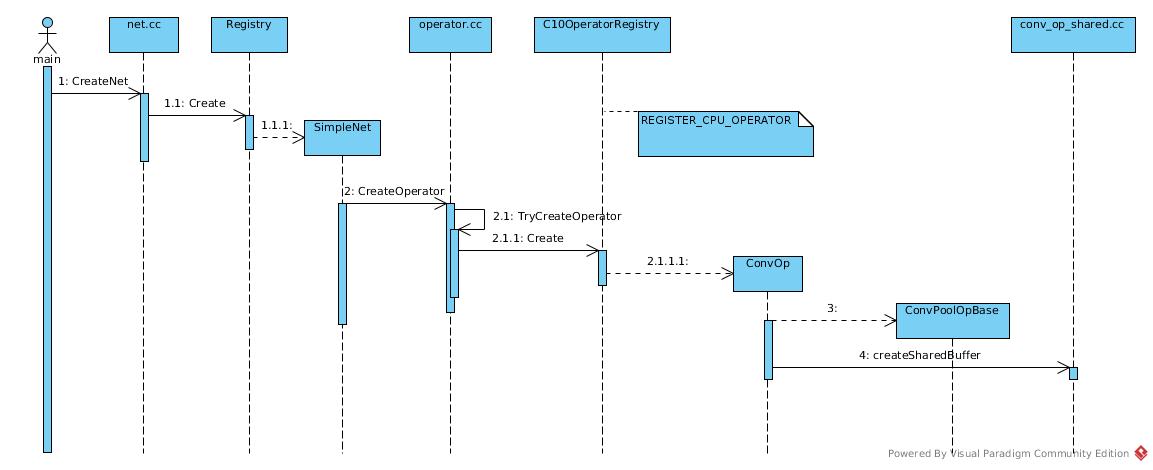
ConvOp Class
The class create an object of certain kernel with specific environment, including context, workspace, order, group etc.
ConvPoolOpBase(const OperatorDef& operator_def, Workspace* ws)
: Operator<Context>(operator_def, ws),
legacy_pad_(
static_cast<LegacyPadding>(this->template GetSingleArgument<int>(
"legacy_pad",
LegacyPadding::NOTSET))),
global_pooling_(
//ZF: GetSingleArgument / GetRepeatedArgument
this->template GetSingleArgument<int>("global_pooling", 0)),
kernel_(this->template GetRepeatedArgument<int>("kernels")),
dilation_(this->template GetRepeatedArgument<int>("dilations")),
stride_(this->template GetRepeatedArgument<int>("strides")),
pads_(this->template GetRepeatedArgument<int>("pads")),
float16_compute_(
this->template GetSingleArgument<bool>("float16_compute", false)),
group_(this->template GetSingleArgument<int>("group", 1)),
order_(StringToStorageOrder(
this->template GetSingleArgument<string>("order", "NCHW"))),
//ZF: What's shared_buffer for?
shared_buffer_(
this->template GetSingleArgument<int>("shared_buffer", 0)),
ws_(ws) {
// Validation and adjustment of above arguments
}
Caffe2 re-arched to replace concepts of layer by concepts of operator, and the conv_op class seemed just have kernel dim parameters registered (maybe not initialized), and the input/output are referred and transferred as name(string) parameters.
OperatorBase::OperatorBase(const OperatorDef& operator_def, Workspace* ws)
: operator_ws_(ws),
operator_def_(std::make_shared<OperatorDef>(operator_def)),
device_option_(
operator_def.has_device_option() ? operator_def.device_option()
: DeviceOption()),
event_(caffe2::make_unique<Event>(device_option_)) {
static GlobalInitIsCalledGuard guard;
for (const string& input_str : operator_def.input()) {
auto* blob = ws->GetBlob(input_str);
CAFFE_ENFORCE(
blob != nullptr,
"op ",
operator_def.type(),
": Encountered a non-existing input blob: ",
input_str);
inputs_.push_back(blob);
}
GetOperatorLogger()(operator_def);
for (const string& output_str : operator_def.output()) {
outputs_.push_back(CHECK_NOTNULL(ws->CreateBlob(output_str)));
}
type_ = operator_def.type();
}
ConvOpDef
TODO: Input and output
initModel and trainModel are both view of actual graphs. initModel adds generator for W and b initiation.
void ModelUtil::AddConvOps(const std::string &input, const std::string &output,
int in_size, int out_size, int stride, int padding,
int kernel, bool test) {
if (!test) {
initModel.AddXavierFillOp({out_size, in_size, kernel, kernel}, output + "_w");
initModel.AddConstantFillOp({out_size}, output + "_b");
}
For example, the Xavier filler is an operator without input blob, and produces output as output_w and output_b.
Then trainModel add the generated definition into data dictionary and generate convopdef with input, w, b as input.
trainModel.AddInput(output + "_w");
trainModel.AddInput(output + "_b");
trainModel.AddConvOp(input, output + "_w", output + "_b", output, stride,
padding, kernel);
}
The initModel runOnce to initialize all parameters and attach the pipeline of input and output
Gradient Op
Generate OpDef then constructs object.
Create OpDef
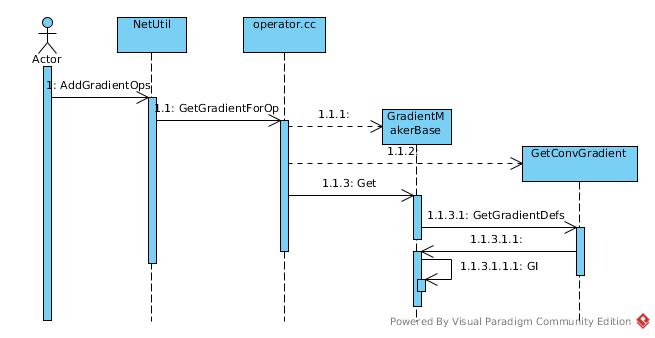 In general, corresponding gradient operator generated by
GetGradientForOp defined in operator.cc:
In general, corresponding gradient operator generated by
GetGradientForOp defined in operator.cc:
GradientOpsMeta GetGradientForOp(
const OperatorDef& def, const vector<GradientWrapper>& g_output) {
std::unique_ptr<GradientMakerBase> maker(
GradientRegistry()->Create(def.type(), def, g_output));
The argument of output is customer-defined, such as:
OperatorDef* NetUtil::AddGradientOp(OperatorDef& op) {
OperatorDef* grad = nullptr;
std::vector<GradientWrapper> output(op.output_size());
for (int i = 0; i < output.size(); i ++) {
output[i].dense_ = op.output(i) + ModelUtil::GetConstName(GRADIENTSUFFIX);
}
The corresponding gradient class constructor called:
//GetGradientForOp
GradientOpsMeta meta = maker->Get();
//operator_gradient.h: GradientMakerBase
virtual GradientOpsMeta Get() {
VerifyOp();
vector<OperatorDef> new_defs = GetGradientDefs();
The implement:
// conv_gradient_op.cc
class GetConvGradient : public GradientMakerBase {
using GradientMakerBase::GradientMakerBase;
vector<OperatorDef> GetGradientDefs() override {
And create the OperatorDef by
// proto_utils.h
OperatorDef CreateOperatorDef ()
Set input and output blob names in
return SingleGradientDef(
def_.type() + "Gradient",
"",
vector<string>{I(0), I(1), GO(0)},
vector<string>{GI(1), GI(2), GI(0)});
The inputs are X, W, Gradient_output; outputs are Gradient_W, Gradient_b, Gradient_X
string I(const int i) {
CAFFE_ENFORCE((i >= 0) && (i < def_.input().size()));
return def_.input(i);
}
string GI(const int i) {
g_input_.at(i).dense_ = GradientName(def_.input(i));
return GradientName(def_.input(i));
}
string GO(const int i) {
return g_output_.at(i).dense_;
}
Create Op
Once the OpDef created and added into train model, the operator object is created as other operators.
The ConvGradientOp is a sub-class of ConvPoolOpBase, it shares shapes of corresponding parameters and the only extra input required is gradient of output in forward propagation.
Run
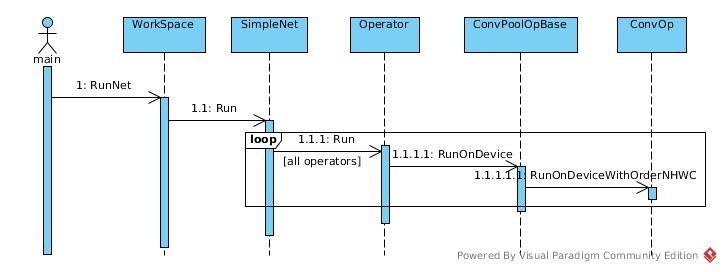
Calculation
RunOnDeviceWithOrderNCHW
bool ConvOp<T, Context>::RunOnDeviceWithOrderNCHW() {
- T: data type
- Context: device etc.
const auto& X = Input(INPUT); const auto& filter = Input(FILTER); auto* Y = Output(0); const int N = X.dim32(0); const int C = X.dim32(1); const int G = group_; CAFFE_ENFORCE_EQ(X.dim(), filter.dim()); const int M = filter.dim32(0); - N: batch size
- C: input channel size
- G: group number
- M: kernel number
- X: image input, N * C * H * W
- Y: output, N * M * H’ * W’
- filter: W, M * C * kernel_H * kernel_W
CAFFE_ENFORCE_EQ( C, filter.dim32(1) * G, "Convolution op: input channels does not match: # of input channels ", C, " is not equal to kernel channels * group: ", filter.dim32(1), "*", G); CAFFE_ENFORCE_EQ( M % G, 0, "The number of output channels is not divisible by group.");In group case, the filter had been grouped in advance. i.e., the channel number in filter = input channel number / group number
int kernel_size = 1; for (std::size_t i = 0; i < kernel_.size(); ++i) { CAFFE_ENFORCE_EQ(filter.dim32(i + 2), kernel_[i]); kernel_size *= kernel_[i]; }Calculate # of elements of kernel = kernel_H * kernel_W, that is size of filter except kernel number and channel number.
ConvPoolOpBase<Context>::SetOutputSize(X, Y, M);Calculate output size of each dim by pad, dilation, stride, kernel size, input size. For example: ``` c++ static inline void ComputeSizeAndPad( //… switch (legacy_pad) { case LegacyPadding::NOTSET: //… *out_size = static_cast
( static_cast (in_size + *pad_head + *pad_tail - dkernel) / stride + 1); break; case LegacyPadding::VALID: //... *out_size = (in_size - dkernel) / stride + 1; break; case LegacyPadding::SAME: { // ... *out_size = (in_size + pad_needed - dkernel) / stride + 1; break; }
Back to Run function:
``` c++
const vector<int> X_dims = GetDims(X);
const vector<int> Y_dims = GetDims(*Y);
const int X_HxW = X.numel() / (N * C);
const int Y_HxW = Y->numel() / (N * M);
const vector<int> img_shape(X.sizes().cbegin() + 1, X.sizes().cend());
vector<int> buffer_shape(Y_dims.size() + 1);
buffer_shape[0] = C * kernel_size;
std::copy(Y_dims.cbegin(), Y_dims.cend(), buffer_shape.begin() + 1);
// The im2col output buffer
const int buffer_size = C * kernel_size * Y_HxW;
- X_dims: dims of single channel image
- Y_dims: dims of single channel output image
- X_HxW: input size for each image per channel
- Y_HxW: output size for each image per channel
- image_shape: channel, H, W
- buffer_shape: im2col output shape
// To prove validation of these strides for group cases
// The dimension of each kernel
const int kernel_dim = C / G * kernel_size; // In fact, C * kernel_size / G
const int X_stride = C * X_HxW;
const int Y_stride = M * Y_HxW;
const int filter_stride = filter.numel() / G;
The stride is the size of data per image per group calculated in one round of process.
if (InputSize() == 3) {
const auto& bias = Input(BIAS);
CAFFE_ENFORCE_EQ(bias.dim(), 1);
CAFFE_ENFORCE_EQ(bias.dim32(0), M);
bias_data = bias.template data<T>();
ConvPoolOpBase<Context>::template SetBiasMultiplier<T>(
Y_HxW, &bias_multiplier_);
}
In bias case, the bias_multiplier_ is set to a matrix of one
TODO: Im2Col implement
if (G == 1) {
math::Gemm<T, Context>(
CblasNoTrans,
CblasNoTrans,
M, // M
Y_HxW, // N
kernel_dim, // K
1.0f, // alpha
filter_data, // W
col_buffer_data, // X
0.0f, //beta
Y_data, // Y
&context_);
}
Y_data = 1.0 * filter_data * col_buffer_data + 0.0 * Y_data
- M: row number of filter_data = M = number of kernels
- N: col number of col_buffer_data = Y_HxW = number of elements of output image per channel
- K: col number and row number of input matrix
= number of elements of kernel
= #channel * kernel_H * kernel_W
else { math::GemmStridedBatched<T, Context>( CblasNoTrans, CblasNoTrans, G, M / G, Y_HxW, kernel_dim, // kernel_dim has had group counted 1.0f, filter_data, filter_stride, col_buffer_data, buffer_size / G, 0.0f, Y_data, Y_stride / G, &context_); } - GemmStridedBatched
- Group
In group case, treat group as batch size.
- G: batch size for GemmStridedBatched (not batch size of DL)
- M / G: M = #row of multiplier#1
- Y_HxW: N + #col of multiplier#2
- kernel_dim: #col of multiplier#1 = #row of multiplier#2
- filter_stride: #elements of multiplier#1 per group = filter.numel() / G filter_numel() != M * C * H * W. In group case, the input has been adjusted as filter_numel() = M * (C / G) * H * W. So, dividing G once is enough.
- buffer_size / G: B stride. The input divided by group
- Y_stride / G: output stride.
So, the multiplication is
- matrix of (M / G, C * Kernel_H * Kernel_W / G) multiplies
- matrix of (C * Kernel_H * Kernel_W / G, Output_H * Output_W)
- = matrix of (M / G, Output_H * Output_W)
if (bias_data != nullptr) { // Bias term can be carried out outside the group definition // to be efficient. math::Gemm<T, Context>( CblasNoTrans, CblasNoTrans, M, Y_HxW, 1, 1.0f, bias_data, bias_multiplier_.template data<T>(), 1.0f, Y_data, &context_); }For bias.
|matrix |row number|col number | |—————–|———-|———————-| |bias_data |M |1 | |bias_multiplier |1 |output_H * output_W | |Y_data |M |output_H * output_W |
X_data += X_stride;
Y_data += Y_stride;
Continue to process next image
if (FLAGS_caffe2_force_shared_col_buffer || shared_buffer_) {
runWithSharedBuffer<Context>(ws_, func);
}
When there is no dead/live-lock, the temporary buffer of im2col result could be shared between between conv_ops.
template <>
void runWithSharedBuffer<CPUContext>(
Workspace* ws,
std::function<void(Tensor* buffer)> f) {
auto* mutexBlob = ws->GetBlob("__CAFFE2_SHARED_CONV_BUFFER_CPU_MUTEX__");
CAFFE_ENFORCE(mutexBlob, "Must call createSharedBuffer() first");
auto* mutexPtr = mutexBlob->GetMutable<std::unique_ptr<std::mutex>>();
std::lock_guard<std::mutex> g(**mutexPtr);
auto* buffer = BlobGetMutableTensor(
ws->GetBlob("__CAFFE2_SHARED_CONV_BUFFER_CPU__"), CPU);
f(buffer);
}
Just get the mutex blob and lock with lock_guard to protect the critical memory.
else {
func(&col_buffer_);
}
Else, use per object tensor:
// ConvOp class
Tensor col_buffer_{Context::GetDeviceType()};
Tensor col_buffer_shape_device_{Context::GetDeviceType()};
Run1x1ConvOnDeviceWithOrderNCHW
There is an optimization (or other consideration?) for 1x1 conv_op. No im2col executed as the result is the same as original matrix. And images processed once for all.
if (G == 1) {
math::GemmStridedBatched<T, Context>(
CblasNoTrans,
CblasNoTrans,
N, // batch_size,
M, //M kernel number, in fact, channel number * new channel number * 1 * 1
HxW, // N image size
C, //K channel size
1.0f, //alpha
filter, // A kernel matrix
0, //a_stride always the same kernel matrix
X, //B image
C * HxW, // b_stride one image
0.0f, //beta
Y, //C
M * HxW, //c_stride new channel number * image size
&context_);
}
For group = 1 case, make N the group number of GemmStridedBatched, the calculation is a single plain 2D image conv_op process.
const int batch_size = N * G;
const int D_X = C / G;
const int D_Y = M / G;
const int X_stride = D_X * HxW;
const int W_stride = D_Y * D_X;
const int Y_stride = D_Y * HxW;
std::vector<const T*> X_ptr(N * G);
std::vector<const T*> W_ptr(N * G);
std::vector<T*> Y_ptr(N * G);
for (int i = 0; i < N; ++i) {
for (int j = 0; j < G; ++j) {
const int index = i * G + j;
X_ptr[index] = X + index * X_stride;
W_ptr[index] = filter + j * W_stride;
Y_ptr[index] = Y + index * Y_stride;
}
}
- batch_size = N * G to cover all the images
- W_ptr[index] = filter + j * W_stride: W_ptr is of size (M / G * C)
Im2col
C10_EXPORT void Im2Col<float, CPUContext, StorageOrder::NCHW>(Im2ColZeroPaddingAndNoDilationNCHW
In simple case:
if (pad_t == 0 && pad_l == 0 && pad_b == 0 && pad_r == 0 && dilation_h == 1 && dilation_w == 1) { Im2ColZeroPaddingAndNoDilationNCHW<float>(Calculate output sizes:
C10_EXPORT void Im2ColZeroPaddingAndNoDilationNCHW( const int C, const int H, const int W, const int kernel_h, const int kernel_w, const int stride_h, const int stride_w, const T* img_data, T* col_data, CPUContext* context) { const int output_h = (H - kernel_h) / stride_h + 1; const int output_w = (W - kernel_w) / stride_w + 1; const int output_size = output_h * output_w; for (int c = 0; c < C; ++c) { for (int kh = 0; kh < kernel_h; ++kh) { for (int kw = 0; kw < kernel_w; ++kw) { const T* src = img_data + kh * W + kw; }The output of Im2Col is a matrix of (channel * K_H * K_W, output_H * output_W), Suppose we are scanning ith element of kernel, i ∈ (0, K_H * K_W), the line i of output contains all the elements of image_data that could be mapped to ith element of kernel.
In theory, each element of image_data could be the corresponding element of ith element of kernel, the only constraint is matrix range. And the constraint had been met by output_h/output_w calculation.
const T* src = img_data + kh * W + kw;
So, the source of each line of output matrix.
if (stride_w == 1) {
CopyMatrix<T, CPUContext>(
output_h,
output_w,
src,
stride_h * W,
col_data,
output_w,
context);
} else {
CopyMatrix<T, CPUContext>(
output_h,
output_w,
src,
stride_h * W,
stride_w,
col_data,
output_w,
1,
context);
}
Copy a matrix with src as element[0][0], #row = output_h, #col = output_w into col_data with row-first-order.
col_data += output_size;
One line of output finished.
Other 2D Case
const int output_h =
(H + pad_t + pad_b - (dilation_h * (kernel_h - 1) + 1)) / stride_h + 1;
const int output_w =
(W + pad_l + pad_r - (dilation_w * (kernel_w - 1) + 1)) / stride_w + 1;
Standard output calculation.
for (int c = 0; c < C; ++c) {
for (int kh = 0; kh < kernel_h; ++kh) {
for (int kw = 0; kw < kernel_w; ++kw) {
Still travels by kernel element.
for (int h = 0; h < output_h; ++h) {
const int h_pad = h * stride_h - pad_t + kh * dilation_h;
Then, to fill in output element one by one.
if (!utils::IsAGeZeroAndALtB(h_pad, H)) {
std::memset(col_data + h * output_w, 0, output_w * sizeof(float));
continue;
}
If it is a pad line, that is, the line padded on the top or bottom of the matrix, set all elements zero.
for (int w = 0; w < output_w; ++w) {
const int w_pad = w * stride_w - pad_l + kw * dilation_w;
col_data[h * output_w + w] = utils::IsAGeZeroAndALtB(w_pad, W)
? img_data[(c * H + h_pad) * W + w_pad]
: 0;
}
The original index of w is (w * stride_w + kw * dilation_w), so no +1, with pad_l counted, the corresponding element of col_data is 0 in padding case, or w_pad in other cases.
CUDA Calculation
Caffe2 has CuDnn integrated and takes it as a unique feature for performance.
Classes
Caffe2 encapsulates the cudnn api to manage multi-thread and multi-stream. The resources are encapsulated in CUDAContext and runtime executions are encapsulated in CuDNNWrapper.

Resource management
Stream
There are a global stream pool per gpu, and lazy-initialized:
CUDAStream.cpp:
CUDAStream getStreamFromPool(...) {
//...
std::call_once(device_flags[device_index], initDeviceStreamState, device_index);
//...
}
static void initDeviceStreamState(DeviceIndex device_index) {
// Switches to the requested device so streams are properly associated
// with it.
CUDAGuard device_guard{device_index};
for (auto i = decltype(kStreamsPerPool){0}; i < kStreamsPerPool; ++i) {
auto& lowpri_stream = low_priority_streams[device_index][i];
auto& hipri_stream = high_priority_streams[device_index][i];
lowpri_stream.device_index = device_index;
hipri_stream.device_index = device_index;
C10_CUDA_CHECK(cudaStreamCreateWithPriority(
&lowpri_stream.stream
, kDefaultFlags
, kLowPriority));
C10_CUDA_CHECK(cudaStreamCreateWithPriority(
&hipri_stream.stream
, kDefaultFlags
, kHighPriority));
}
}
A thread-local stream defined per CPU thread to ensure that there is at most one stream attach to one CPU thread. The attachment is lazy-initialized.
CUDAStream.cpp
static thread_local CUDAStreamInternals** current_streams = nullptr;
CUDAStream getDefaultCUDAStream(DeviceIndex device_index) {
initCUDAStreamsOnce();
if (device_index == -1) device_index = current_device();
check_gpu(device_index);
return CUDAStream_fromInternals(&default_streams[device_index]);
}
static void initCUDAStreamsOnce() {
// Inits default streams (once, globally)
std::call_once(init_flag, initGlobalStreamState);
if (current_streams) return;
// Inits current streams (thread local) to default streams
current_streams = (CUDAStreamInternals**) malloc(num_gpus * sizeof(CUDAStreamInternals*));
for (auto i = decltype(num_gpus){0}; i < num_gpus; ++i) {
current_streams[i] = &default_streams[i];
}
}
But Operator does not manipulate CUDAStream directly. The access to stream is wrapped in CuDNNWrapper and attached to CPU thread by another thread_local object.
ThreadLocalCUDAObjects& CUDAContext::getCudaObjects() {
static thread_local ThreadLocalCUDAObjects cuda_objects_;
return cuda_objects_;
}
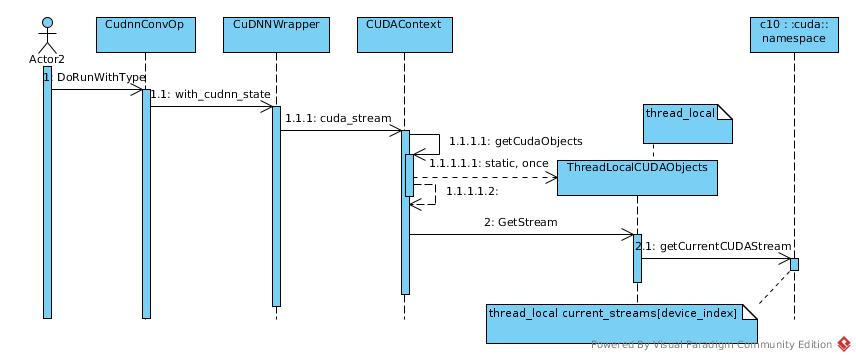
From view of Operator, the object of current_streams could be stored in ThreadLocalCUDAObject as a merely local field.
While the stream of current thread is also referred in other cases, often in accessory audit cases.
So, current_streams is also a thread_local variable.
And there is local variable of current streams defined in ThreadLocalCUDAObjects,
but seemed not have been used sensibly.
Anyway, I think the design of this module is still on-going. It is not mature yet.
Handle
Besides stream, cudnn handle is also mandatory resource. The cudnnHandle_t is bound to device_index = gpu_id. The gpu_id is stored in CUDAContext which initialized in Operator constructor.
class Operator : public OperatorBase {
public:
explicit Operator(const OperatorDef& operator_def, Workspace* ws)
: OperatorBase(operator_def, ws), context_(operator_def.device_option()) {
Execution
Two functions of wrapper are used in execution.
First one is to get the handle. As mentioned above, the handle is bound to gpu_id that set to context and put into Operator object in construction.
That is, there are multi handles point to the same device, while one object is allowed to use only one handle (gpu).
cudnnHandle_t inline_cudnn_handle() {
return context_->cudnn_handle();
}
cudnnHandle_t cudnn_handle() {
return getCudaObjects().GetCudnnHandle(gpu_id_);
}
The other one is the stream. As all streams are de-queued from the same stream pool, there may be multi CPU threads share the same stream, the stream has been encapsulated in CuDNNState that provides a mutex lock to serialize actions on the same stream.
template <typename F>
void with_cudnn_state(size_t state_idx, F&& f) {
CAFFE_ENFORCE(
state_idx < CAFFE2_COMPILE_TIME_MAX_CUDNN_STATES, "Invalid state_idx");
auto& sync_state = cudnn_states()[context_->device_id()][state_idx];
DeviceGuard dg(context_->device_id());
// We need to serialize execution on the CuDNNState as we can't
// allow multiple threads to race through the cudaEventRecord
// calls (so a worker thread might wait on another worker thread's
// execution)
std::lock_guard<std::mutex> g(sync_state.mutex);
if (!sync_state.state.get()) {
sync_state.state.reset(new CuDNNState(context_->device_id()));
}
CHECK_NOTNULL(sync_state.state.get())->execute(context_->cuda_stream(), f);
}
Implement
The implementation with cudnn is just standard usage as following sections show with just some details:
- Half: F16 = 16-bit float data type. TRAINING WITH MIXED PRECISION
- group conv: For cudnn with version >= 7.0.0, the group parameter is used twice.
The first one is to take set group attribute of conv_desc, as :
cudnnSetConvolutionGroupCount(conv_desc_, group_);The second one is to set input channel number of kernel desc, as:
cudnnSetFilter4dDescriptor( filter_desc_, cudnnTypeWrapper<T_W>::type, GetCudnnTensorFormat(order_), MM, C / group_, kernel_h(), kernel_.size() == 1 ? 1 : kernel_w());Don’t know the logic why MM requires no special treatment. Will it be more natural to make them symmetry?
- algorithm choose:
The algorithms supported are declared at cudnnConvolutionFwdAlgo_t:
If not determined in advance, there is a exhausting search for fastest algorithm
by cudnnFindConvolutionForwardAlgorithmEx
Forward Propagation
The sequence of cudnn implementation:
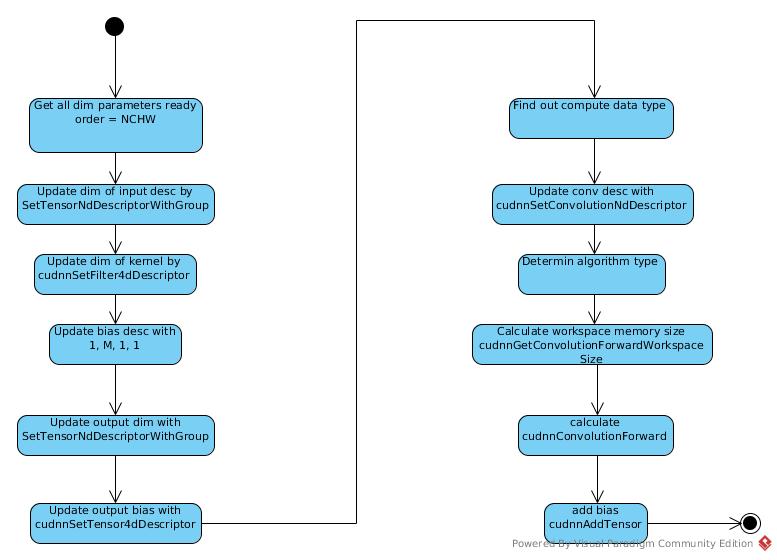
The link for cudnn conv tutorial
Back Propagation
The back-propagation is implemented in similar way as
